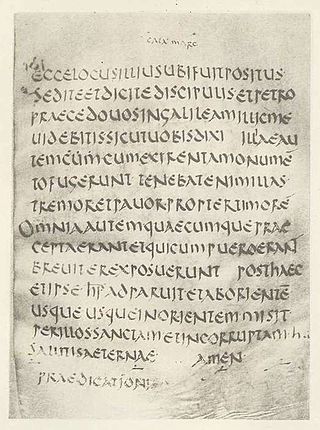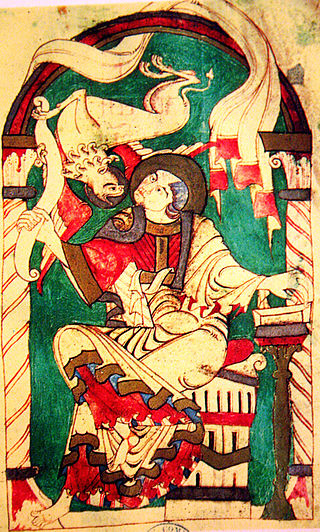
The Codex Claromontanus V, designated by h in traditional system or by 12 in the Beuron system, is a 4th- or 5th-century Latin manuscript of the New Testament. The text, written on vellum.

The Codex Claromontanus V, designated by h in traditional system or by 12 in the Beuron system, is a 4th- or 5th-century Latin manuscript of the New Testament. The text, written on vellum.
The manuscript contains the text of the four Gospels with lacunae in Matthew 1:1-3:15; 14:44-18:12 on 66 parchment leaves. It contains the Ammonian Sections and Eusebian Canons, it uses abbreviations. [1]

The text of the codex represents Old Latin textual tradition in the Gospel of Matthew. In rest of Gospels it has text of Vulgate. [1]
The nomina sacra are written in an abbreviated way. [2]
The manuscript was bought by Pius VI (1775-1798). [3]
The text of the codex was edited by Paul Sabatier, Angelo Mai, Johannes Belsheim, and Jülicher.
The codex is located, in the Vatican Library (Lat. 7223) at Vatican. [1]

The Codex Vaticanus, designated by siglum B or 03, δ 1, is a fourth-century Christian manuscript of a Greek Bible, containing the majority of the Greek Old Testament and the majority of the Greek New Testament. It is one of the four great uncial codices. Along with Codex Alexandrinus and Codex Sinaiticus, it is one of the earliest and most complete manuscripts of the Bible. The codex has been dated palaeographically to the 4th century.

The Codex Alexandrinus, designated by the siglum A or 02, δ 4, is a manuscript of the Greek Bible, written on parchment. Using the study of comparative writing styles (palaeography), it has been dated to the fifth century. It contains the majority of the Greek Old Testament and the Greek New Testament. It is one of the four Great uncial codices. Along with Codex Sinaiticus and Vaticanus, it is one of the earliest and most complete manuscripts of the Bible.

Codex Claromontanus, symbolized by Dp, D2 or 06 (in the Gregory-Aland numbering), δ 1026 (von Soden), is a Greek-Latin diglot uncial manuscript of the New Testament, written in an uncial hand on vellum. The Greek and Latin texts are on facing pages, thus it is a "diglot" manuscript, like Codex Bezae Cantabrigiensis. The Latin text is designated by d (traditional system) or by 75 in Beuron system.

The Codex Brixianus, designated by f, is a 6th-century Latin Gospel Book which was probably produced in Italy.

Codex Bobiensis or Bobbiensis is one of the oldest Old Latin manuscripts of the New Testament. The fragmentary text contains parts of the Gospel of Mark and Gospel of Matthew.
Codex Colbertinus, designated by 6 or c, is a Latin manuscript of the Bible. Its version of the four Gospels and Book of Acts follows the Vetus Latina, while the rest of the New Testament follows the Vulgate. It was written in the 11th or 12th century, probably in southern France.

Codex Petropolitanus Purpureus, designated by N or 022, ε 19, is a Greek New Testament codex containing the four Gospels. Using the study of comparative writing styles (palaeography), it has been assigned to the 6th century CE.

Codex Boernerianus, designated by Gp, G3 or 012 (in the Gregory-Aland numbering of New Testament manuscripts), α 1028 (in the von Soden numbering of New Testament manuscripts), is a small New Testament manuscript made of parchment which contains the majority of the Pauline epistles. Using the study of comparative writing styles (paleography), the manuscript has been dated to the 9th century CE. The name of the codex derives from the theology professor Christian Frederick Boerner, to whom it once belonged. The manuscript has several gaps.

Codex Sangallensis, designated by Δ or 037, ε76, is a Greek-Latin diglot uncial manuscript of the four Gospels. Using the study of comparative writing styles (palaeography), it is usually dated to the 9th century CE, though a few palaeographers would place it in the 10th century CE. It was given its current name by biblical scholar Johann Martin Augustin Scholz in 1830.

Dura Parchment 24, designated as Uncial 0212, is a Greek uncial manuscript of the New Testament. The manuscript has been assigned to the 3rd century, palaeographically, though an earlier date cannot be excluded. It contains some unusual orthographic features, which have been found nowhere else.

Minuscule 157, ε 207, is a Greek minuscule manuscript of the New Testament Gospels, on vellum. According to the colophon it is dated to the year 1122. Formerly the date was wrongly deciphered as 1128. It has complex contents and full marginalia.
The Codex Vindobonensis Lat. 1235, designated by i or 17, is a 6th-century Latin Gospel Book. The manuscript contains 142 folios. The text, written on purple dyed vellum in silver ink, is a version of the old Latin. The Gospels follow in the Western order.

The Codex Veronensis, designated by siglum b or 4, is a 5th-century Latin Gospel Book. The text, written on purple dyed vellum in silver and occasionally gold ink, is a version of the old Latin. The Gospels follow in the Western order.
The Codex Palatinus, designated by e or 2, is a 5th-century Latin Gospel Book. The text, written on purple dyed vellum in gold and silver ink, is a version of the old Latin. Most of the manuscript was in the Austrian National Library at Vienna until 1919, when it was transferred to Trento, where it is now being kept as Ms 1589 in the Library of Buonconsiglio Castle. Two leaves were separated from the manuscript in the 18th century: one is now in the library of Trinity College, Dublin, the other in the British Library in London.

The Codex Corbeiensis I, designated by ff1 or 9, is an 8th, 9th, or 10th-century Latin New Testament manuscript. The text, written on vellum, is a version of the old Latin. The manuscript contains 39 parchment folios with the text of the four Gospels, Acts of the Apostles, and General epistles.
The Codex Corbeiensis II, designated by ff2 or 8, is a 5th-century Latin Gospel Book. The text, written on vellum, is a version of the old Latin. The manuscript contains 190 parchment folio with the text of the four Gospels with lacunae. Written in a beautiful round uncial hand.
The Codex Floriacensis, designated by h in traditional system or by 55 in the Beuron system, is a 6th-century Latin manuscript of the New Testament. The text, written on vellum, is a palimpsest. Another name of the manuscript is Fleury Palimpsest or Palimpsestus Floriacensis. It is one of the eight Old-Latin manuscripts with text of Apocalypse.

Codex Sangallensis 1395 is a nineteenth-century compilation of fragments, and includes a 5th-century Latin manuscript of the New Testament, designated by Σ. The text, written on vellum, is a version of the Latin Vulgate.

The great uncial codices or four great uncials are the only remaining uncial codices that contain the entire text of the Bible in Greek. They are the Codex Vaticanus in the Vatican Library, the Codex Sinaiticus and the Codex Alexandrinus in the British Library, and the Codex Ephraemi Rescriptus in the Bibliothèque nationale de France in Paris.